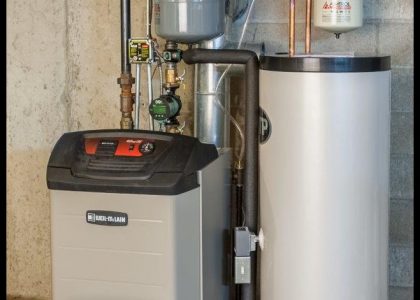In the 1800’s steam was king! It ran the trains, industries, ships, heated the largest buildings and the finest homes. Steam heating continued in this respect into the early 1900’s to even smaller homes, providing distinctive styling and comfort to the American Lifestyle.
Those beautiful Victorians, updated Colonials, Southern Manors, Seaside Mansions and latter day Bungalows were all heated by steam as the method of choice. They featured ornate radiation and huge central boilers fired by coal, cotton waste, corncobs, peat moss or wood — and lots of it!
The age of cheap energy has passed and so seemingly the Age of Steam Heating ….. but not so fast! There is an old adage of “throwing the baby out with the bath water”, cautioning us to not dispose of the good to rid us of the bad. This aptly applies to steam heating in our opinion.
The simplicity and comfort level of steam heating is unarguable. Those well placed, aesthetic and space efficient radiators emit both heat with a light hiss of escaping steam simultaneously heating AND humidifying our air. Room temperature can be reduced somewhat without a comfort penalty. To duplicate this environment requires mechanical creation using power humidifiers or more complicated HVAC Systems. (That’s also why common homes had a tub of water on the heating stove.)
Three usage factors affect steam heating:
- Fuel efficiency. Those old steamers have heat exchanger passages and flue pipes intended for large, continuous combustion, low temperature fires that are the polar opposites of small passage, high temperature oil or gas fired systems.
- Installation or repair cost. Residential steamfitting is one of those fading (and therefore expensive) arts, it seems.
- Flexibility. Those big iron pipes don’t stretch or move readily. Extending a system seems formidable.
Not so fast, again!
You may have noticed that virtually nothing ever happens to the radiators and piping in your system — the distribution side of things. Yes, a radiator vent may stick so it can’t be adjusted. So you unscrew it (with the steam turned down) and replace it. A valve stem leaks, so you tighten or pack it. Unlike hydronic systems, no gurgling, noisy, tinny registers, circulators, relays or vents to go bad. Steam provides the absolute in physical non-mechanical distribution simplicity, efficiency and durability. This is the “baby” in our analogy.
The “bath water” is that beast of a boiler — the dinosaur. This is where virtually all of the efficiency gains are to be had (plus a little smart usage). Additionally, this is where the third factor (flexibility) must be introduced and discussed in common.
A steam boiler is like putting a partially-filled pot of water on the stove with a perforated cover over it to let steam escape in a controlled manner. When you turn on the stove the water rose in temperature until it generated steam. If you don’t need steam the water in the pot is still hot in degree and usable heat. There are therefore two usable components in a steam boiler — hot water and steam. As in past steam systems you can employ the hot water component to provide domestic hot water and additional forced hot water zone heating. So if you want to stretch your steam system to heat the garage or that added room, it’s available.
That big iron hulk down there was designed with complimentary, rather large distribution piping. Hopefully at some point or through your efforts heat loss of the building has been improved. You don’t need the distribution size as a result. This is not necessarily a detriment, however. What is more important is to not under size the replacement boiler and it’s steaming time.
As you create steam in a boiler, the boiler water level is reduced as steam rises throughout the distribution (pipes & radiators). Steam is condensed in the radiators giving heat, and this condensate (now as hot water) cools, slowly trickling back to the boiler. If you generate a lot of steam rapidly from a too small boiler, the water level drops quickly. The low water indicator feeds a quantity of new water into the boiler by design. Then the eventual returning surge of condensate “floods” the boiler, reducing or limiting its ability to create steam (heat). Make-up water management can be important.
Worse, in the smaller boiler scenario there is also the danger of overheating the boiler to the extent that thermal shocking can be induced by replacement water, damaging the boiler.
There are tricks to reduce these scenarios, but there is one guideline that works every time:
Boiler Weight (Size) and Water Capacity = Performance Efficiency with Longer Boiler Life (Just look at the unit you are replacing.)
We invite you therefore to compare the weights and capacities of Weil-McLain Steam Boilers with all of its competitors.
If you are still determined to be rid of the old steam system in entirety, so be it. But save back those radiators. Don’t give your installer an extra payday.

